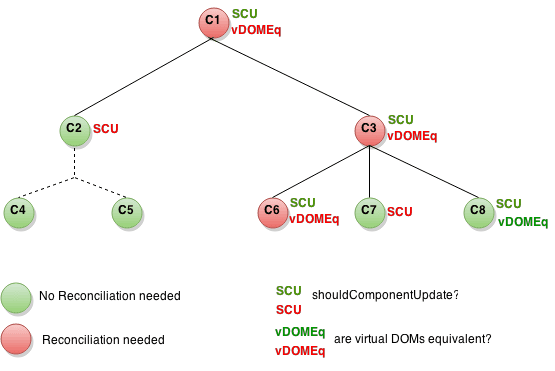性能优化
基于 Webpack 等构建工具打包带来的性能优化本章略过,主要讨论 React 内部的针对性优化
虚拟滚动
参考库
虚拟滚动参考react-window和react-virtualized两个热门库
原理
虚拟列表指的是「可视区域渲染」的列表。有三个概念需要了解:
- 滚动容器元素:一般情况下,滚动容器元素是 window 对象,也可以通过布局的方式,在某页面内指定一个或多个滚动容器元素,滚动也分横向和纵向滚动,滚动容器元素在滚动时每个列表项只是渲染一些纯文本。在这里我们只讨论元素纵向滚动
- 可滚动区域:滚动容器元素的内部内容区域。假设有 100 条数据,每个列表项的高度是 50,那么可滚动的区域高度就是 100*50。可滚动区域当前具体高度值一般通过滚动容器元素的 scrollHeight 属性获取
- 可视区域:滚动容器元素的视觉可见区域。如果容器元素是 window 对象,可视区域就是浏览器的视口大小(即视觉视口);如果某个容器元素 div,其高度 300,右侧有纵向滚动条,那么视觉可见的区域就是可视区域
虚拟滚动的实现是在处理用户滚动时,改变列表在可视区域的渲染部分,其具体步骤如下
- 计算当前可见区域起始数据的 startIndex
- 计算当前可见区域结束数据的 endIndex
- 计算当前可见区域的数据,并渲染到页面中
- 计算 startIndex 对应的数据在整个列表中的偏移位置 startOffset,并设置到列表上
- 计算 endIndex 对应的数据相对于可滚动区域最底部的偏移位置 endOffset,并设置到列表上
参考链接:https://blog.csdn.net/terrychinaz/article/details/112552673
rerender 优化

在这张组件树图例中,C6 触发的更新引起组件树重新渲染(rerender),如果避开无需重渲染的组件:C2 及其子组件、C3 的子组件 C7、C8,最终执行最小量的重渲染组件就只会有 C1-C3-C6,从而提高渲染效率优化加载性能
shouldComponentUpdate
假设场景:组件只有当props.color或state.count的值改变才需要更新,可以使用 shouldComponentUpdate 来检查
class CounterButton extends React.Component {
constructor(props) {
super(props);
this.state = { count: 1 };
}
shouldComponentUpdate(nextProps, nextState) {
if (this.props.color !== nextProps.color) {
return true;
}
if (this.state.count !== nextState.count) {
return true;
}
return false;
}
render() {
return (
<button
color={this.props.color}
onClick={() => this.setState((state) => ({ count: state.count + 1 }))}
>
Count: {this.state.count}
</button>
);
}
}
如果 color 和 count 的值没有改变,则组件不会触发 rerender
PureComponent
仅对 props 和 state 中的所有字段作浅比较的情况,使用React.PureComponent即可
class CounterButton extends React.PureComponent {
constructor(props) {
super(props);
this.state = { count: 1 };
}
render() {
return (
<button
color={this.props.color}
onClick={() => this.setState((state) => ({ count: state.count + 1 }))}
>
Count: {this.state.count}
</button>
);
}
}
memo
memo 是 React 面向函数式组件提供的浅比较 API,作用与PureComponent相同,包裹函数组件来阻止函数组件不必要的更新
export default memo(function CounterButton(props) {
const [count, setCount] = useState(1);
return (
<button color={props.color} onClick={() => setCount(count + 1)}>
Count: {count}
</button>
);
});
useMemo
详见惰性取值Hook
useCallback
详见惰性函数Hook
不可变数据操作
众所周知,React 遵守组件状态不可变的理念,通常在修改 state 的时候都需要使用 ES6 的解构,或者新对象赋值
immer.js 为我们提供了全新的无须使用解构即可触发 React 更新的写法
传统写法:
const App = () => {
const [state, setState] = useState({
name: "lin",
todoList: {
list: [{ name: "吃饭", done: true }],
},
});
const addTodoList = () => {
setState((state) => ({
name: state.name,
todoList: {
list: [...state.todoList.list, { name: "睡觉", done: true }],
},
}));
};
};
使用immer:
import { produce } from "immer";
const App = () => {
const [state, setState] = useState({
name: "lin",
todoList: {
list: [{ name: "吃饭", done: true }],
},
});
const addTodoList = () => {
setState(
produce((state) => {
state.todoList.list.push({ name: "睡觉", done: true });
})
);
};
};
immer 实现原理
immer 会通过原有的 state 基础状态生成一个可编辑的 draft 状态,开发者修改数据,修改完成后 immer 只会针对数据有变化的部分进行深拷贝,然后返回一个新状态,整个过程不影响初始状态
- draft 的实现
draft 本质是初始状态的代理,核心是为了不让开发者直接触及到原始状态,而是在其代理上进行修改,再根据代理状态的变化来生成新状态
immer 中对于 draft 的实现在支持 Proxy 语法环境时使用 Proxy 实现,不支持 Proxy 语法环境时使用 defineProperty 实现
为避免内存泄露并保证安全性,immer 还使用Proxy.revocable创建了可撤销的代理对象,draft 函数执行完成后调用 revoke 方法销毁 draft 对象
按需深拷贝的实现
immer 中通过对代理状态的劫持来实现按需标记更改
当在 produce 的回调函数(recipe 函数)中修改 draft 数据时,就会通过 set 或 deleteProperty 中的 markChange 完成变化追踪,同时通过
state.copy_来记录修改后的值,并通过state.assigned_记录修改的类型数据修改完成后,通过
state.copy_和state.modified_生成新的状态上述核心思想就是通过递归遍历子属性,用之前的标记判断子属性部分的数据是否有被修改过,如果未被修改则直接使用原始状态中的引用,否则就用
state.copy_记录的更新内容来重设子属性数据
参考链接:http://lixianglong.cn/2022/02/25/application/fore-end/nodejs/immer.js 入门/
